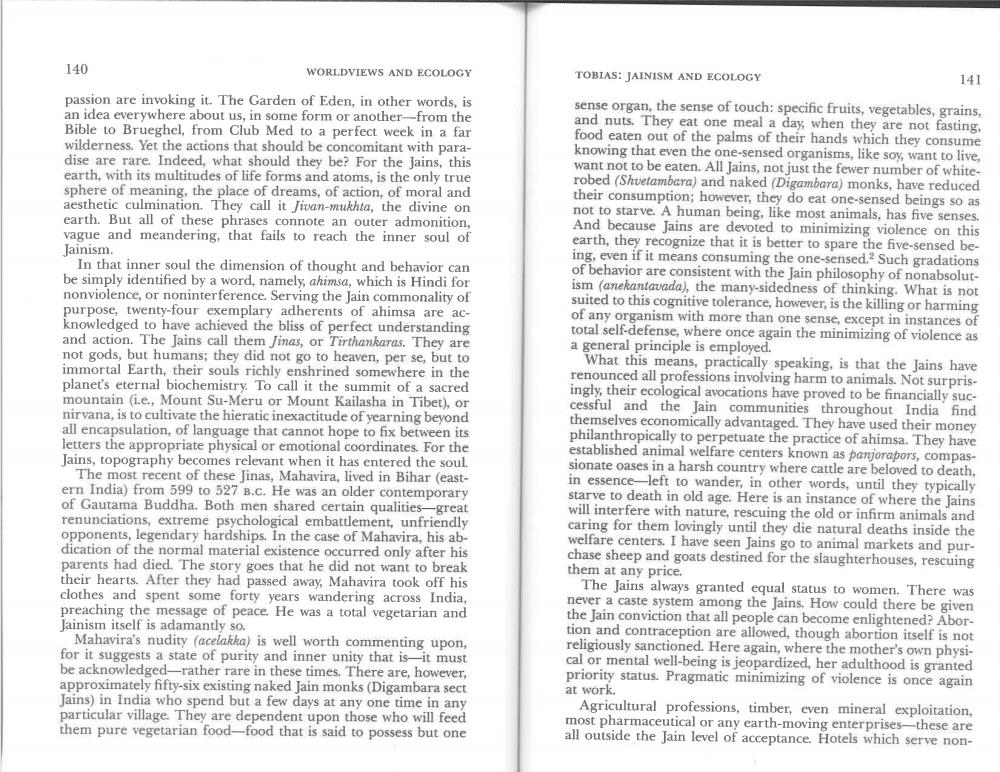Book Title: Jainism and Ecology Views of Nature Nonviolence and Vegeteranism Author(s): Michael Tobias Publisher: Michael Tobias View full book textPage 2
________________ 140 WORLDVIEWS AND ECOLOGY TOBIAS: JAINISM AND ECOLOGY 141 passion are invoking it. The Garden of Eden, in other words, is an idea everywhere about us, in some form or another-from the Bible to Brueghel, from Club Med to a perfect week in a far wilderness. Yet the actions that should be concomitant with paradise are rare. Indeed, what should they be? For the Jains, this earth, with its multitudes of life forms and atoms, is the only true sphere of meaning, the place of dreams, of action, of moral and aesthetic culmination. They call it Jivan-mukhta, the divine on ut all of these phrases connote an outer admonition, vague and meandering, that fails to reach the inner soul of Jainism. In that inner soul the dimension of thought and behavior can be simply identified by a word, namely, ahimsa, which is Hindi for nonviolence, or noninterference. Serving the Jain commonality of purpose, twenty-four exemplary adherents of ahimsa are acknowledged to have achieved the bliss of perfect understanding and action. The Jains call them Jinas, or Tirthankaras. They are not gods, but humans; they did not go to heaven, per se, but to immortal Earth, their souls richly enshrined somewhere in the planet's eternal biochemistry. To call it the summit of a sacred mountain (ie, Mount Su-Meru or Mount Kailasha in Tibet), or nirvana, is to cultivate the hieratic inexactitude of yearning beyond all encapsulation, of language that cannot hope to fix between its letters the appropriate physical or emotional coordinates. For the Jains, topography becomes relevant when it has entered the soul. The most recent of these Jinas, Mahavira, lived in Bihar (eastern India) from 599 to 527 B.C. He was an older contemporary of Gautama Buddha. Both men shared certain qualities—great renunciations, extreme psychological embattlement, unfriendly opponents, legendary hardships. In the case of Mahavira, his abdication of the normal material existence occurred only after his parents had died. The story goes that he did not want to break their hearts. After they had passed away, Mahavira took off his clothes and spent some forty years wandering across India, preaching the message of peace. He was a total vegetarian and Jainism itself is adamantly so. Mahavira's nudity (acelakka) is well worth commenting upon, for it suggests a state of purity and inner unity that is-it must be acknowledged-rather rare in these times. There are, however, approximately fifty-six existing naked Jain monks (Digambara sect Jains) in India who spend but a few days at any one time in any particular village. They are dependent upon those who will feed them pure vegetarian food-food that is said to possess but one sense organ, the sense of touch: specific fruits, vegetables, grains, and nuts. They eat one meal a day, when they are not fasting, food eaten out of the palms of their hands which they consume knowing that even the one-sensed organisms, like soy, want to live, want not to be eaten. All Jains, not just the fewer number of whiterobed (Shwetambara) and naked (Digambara) monks, have red their consumption; however, they do eat one-sensed beings so as not to starve. A human being, like most animals, has five senses. And because Jains are devoted to minimizing violence on this earth, they recognize that it is better to spare the five-sensed being, even if it means consuming the one-sensed. Such gradations of behavior are consistent with the Jain philosophy of nonabsolutism (anekantavada), the many-sidedness of thinking. What is not suited to this cognitive tolerance, however, is the killing or harm of any organism with more than one sense, except in instances of total self-defense, where once again the minimizing of violence as a general principle is employed. What this means, practically speaking, is that the Jains have renounced all professions involving harm to animals. Not surprisingly, their ecological avocations have proved to be financially successful and the Jain communities throughout India find themselves economically advantaged. They have used their philanthropically to perpetuate the practice of ahimsa. They have established animal welfare centers known as panjorapors, compassionate oases in a harsh country where cattle are beloved to death, in essence-left to wander, in other words, until they typically starve to death in old age. Here is an instance of where the Jains will interfere with nature, rescuing the old or infirm animals and caring for them lovingly until they die natural deaths inside the enters. I have seen Jains go to animal markets and purchase sheep and goats destined for the slaughterhouses, rescuing them at any price. The Jains always granted equal status to women. There was never a caste system among the Jains. How could there be given the Jain conviction that all people can become enlightened? Abortion and contraception are allowed, though abortion itself is not religiously sanctioned. Here again, where the mother's own physical or mental well-being is jeopardized, her adulthood is granted priority status. Pragmatic minimizing of violence is once again at work. Agricultural professions, timber, even mineral exploitation, most pharmaceutical or any earth-moving enterprises-these are all outside the Jain level of acceptance. Hotels which serve nonPage Navigation
1 2 3 4 5 6
